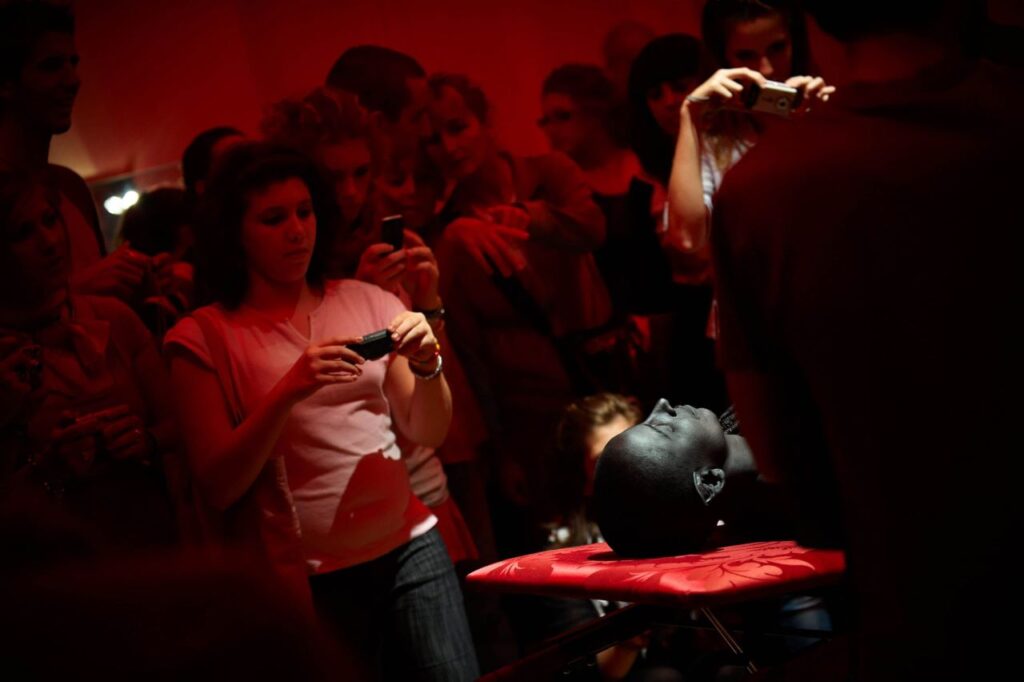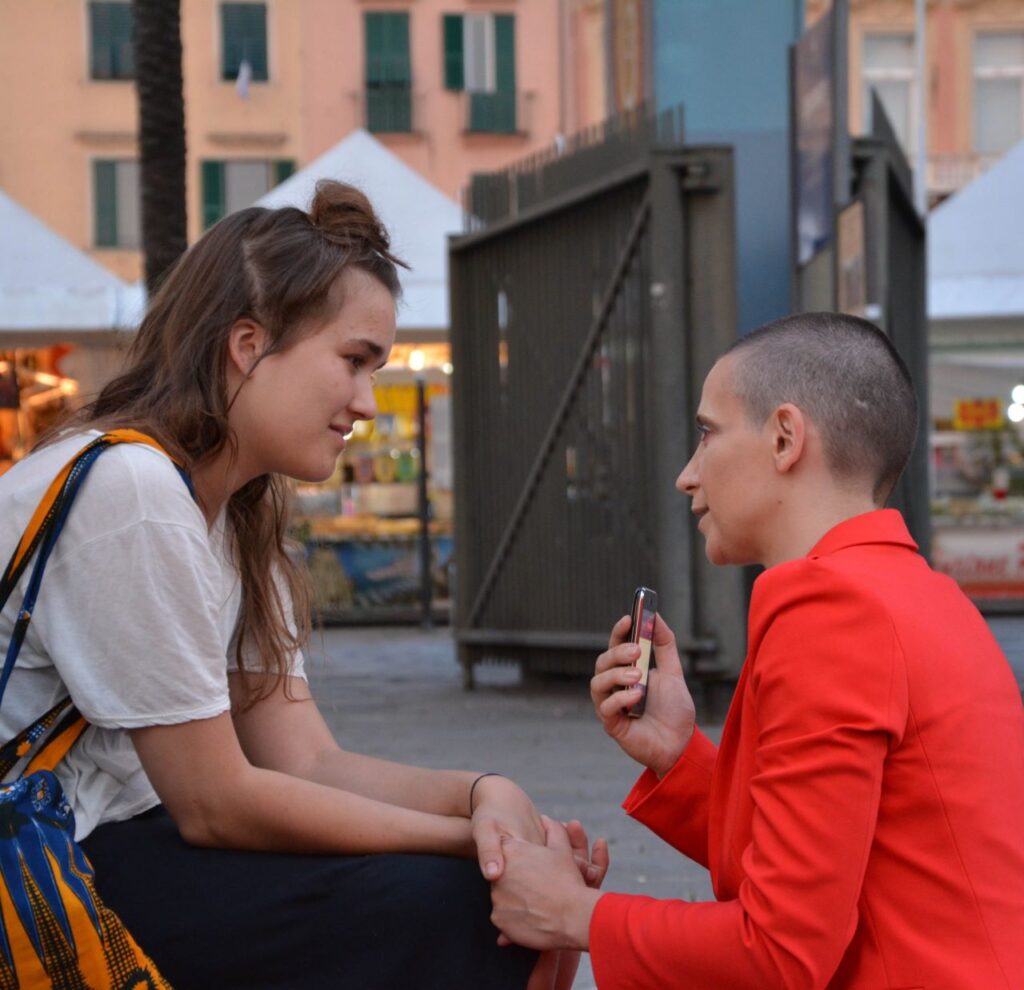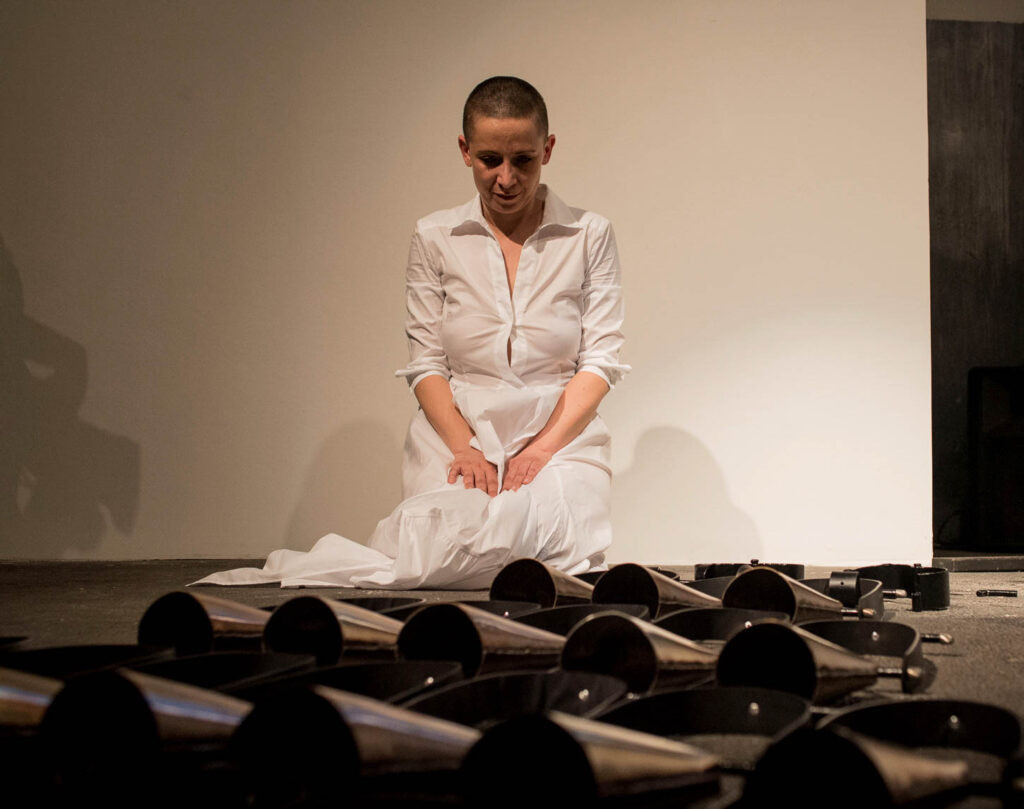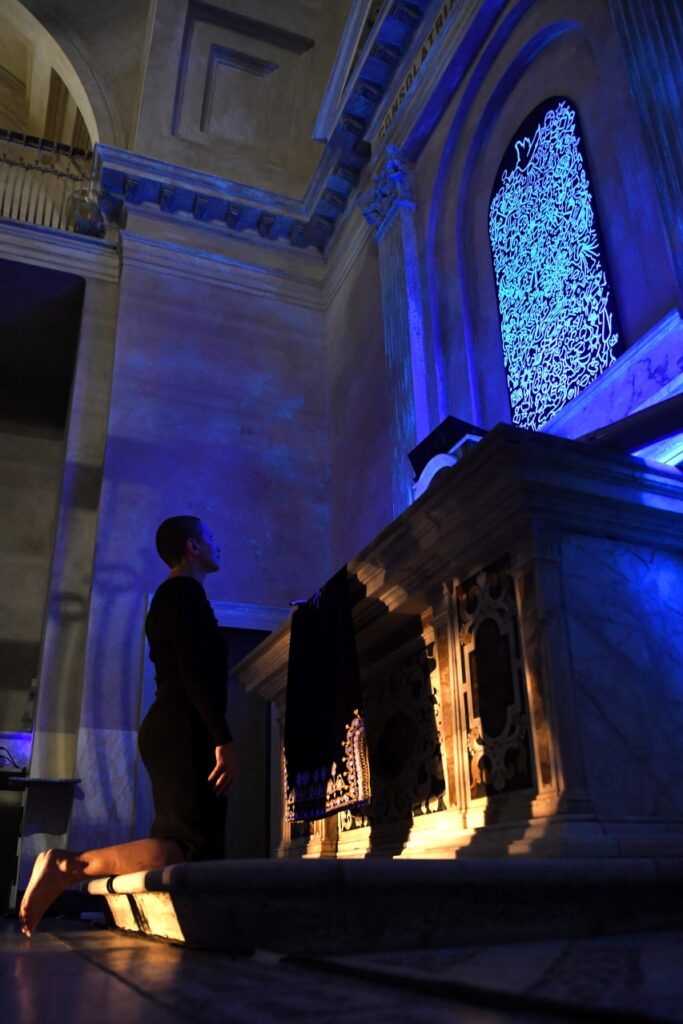by Enrico Maria Davoli
Mona Lisa Tina (Francavilla Fontana 1977) is one of the most representative figures on the italian Performance Art scene today. An art therapist accredited to major educational, museum and health institutions, she lives and works in Bologna, where she attended the Academy of Fine Arts. From her first experiences, her approach to performance combines elements of universal, simple and recognisable rituality with refined and elegant staging. The use of a wide range of installation, technology and multimedia resources, both during the performative action in real time and in the photographic and videographic postproduction, gives his work a strong plastic, chromatic and emotional density. Archetypal gestures such as breathing, walking barefoot, whispering, declaiming, embracing, caressing, intoning a lament create the conditions for an inescapable climax. The participants in the performance become the protagonists of a possible, everyday redemption. Mona Lisa Tina carefully plans every detail of her performances, creating around herself an atmosphere of regality, an afflatus that turns her work into an architecture of the emotions, capable of framing the time and space in which it takes place. We therefore asked her a series of questions about the signs of recognition, both aesthetical and ethical, present in all her artistic research. The artist's website www.monalisatina.it is the source of all images accompanying this interview.
Perhaps partly because of the low-resolution, black-and-white images of pioneers such as Vito Acconci, Carolee Schneemann and the Abramović-Ulay duo, there is a tendency to associate Performance Art (and neighbouring Body Art) with a series of poor, if not downright unadorned, artistic procedures. But the landscape has changed a lot since a few decades ago. What are the internal and external reasons explaining this development?
It’s exactly as you say. Over time, Performance Art has been transformed by the integration of contemporary audio/video tools and devices. Thanks to them, the artist has empowered and transcended the limits of the Body and the risk of succumbing to his own physical transience, making his performative actions eternal thanks to digital reproducibility. As for changes outside the performative settings, I believe they depend on the process of cultural and scientific evolution, in a broad sense, that is taking place everywhere. Performance artists have felt the need to express themselves through more sophisticated and contemporary means, transcending the geographical boundaries of their countries of origin. The internal reasons for these aesthetic changes, on the other hand, are largely linked to the artist’s biography, the cultural stimuli received from outside, the professional encounters/clashes with their reference figures, their age and, more generally, the expressive urgency and sharing of their Art.

The materials and objects you have used in your performances over time, offer an image that fits very well with the original and more concrete notion of ornamentum as we read it in a Latin dictionary; on the one hand, “apparatus”, “equipment”, “armour”, “harness”, on the other hand, the terms that are more common today, like “embellishment” and “ornamentation”. What do you think about it?
First of all, I can answer that the objects I use acquire a very precise meaning and role depending on the project in question: certainly the terms “apparatus” and “armour” can be conceptually related to them. Furthermore, the term “ornamentation”, understood as the integration of one or more aesthetic objects into the performance, with purposes beyond mere embellishment, also seems appropriate to me. From my perspective as a visual artist, and not as a semiologist or linguist, I am expressing an opinion that I’m aware may be controversial.
If I were to attempt an inventory of the “ornaments” with which you realise your performances, a first relevant modality you have used in the past is a layer of paint applied directly to the skin, for example the burnishing used in Obscuratio (2008) and Human (2009). Was it an erasure, a metamorphosis, a sublimation?
Throughout art history, black has been associated with many symbolic meanings, understood as achromia and absence of light. In some of my previous performances – Obscuratio and Human come to mind – I used an opaque black pigment to completely cover the entire surface of my Body with the aim of concealing and confusing my gender identity, if only momentarily for the duration of the action. So black has more than one meaning for me. Firstly, that of a particular emotional state of introspection and psychic toil on the part of the artist, prior to the attainment of a new consciousness that follows the constructive action of the work of art. As stated in the various treatises of ancient alchemy, the process of transforming matter is divided into three main stages, which characterise the chromatic transformation of metals until it reaches its culmination; Gold. This transformation does not only concern the physical state of matter, but also has an inner meaning related to the spiritual evolution of being. In my personal experience, before, during and at the end of a performance, I always go through different emotional states of great intensity, which can be related to the phases of the alchemical process: Nigredo, Albedo, Rubedo and finally Gold. The Nigredo phase can be seen as the moment before the action, when the artist is intensely and introspectively focused on himself and his body. The Albedo phase is the initial instance of the action in which the artist, not through words but through his gaze and physical presence, establishes a dimension of empathy and trust with the audience present. The Rubedo phase refers to the full unfolding of the action, in which the artist and the audience participate in the work, being emotionally and totally involved. The golden phase, after a reciprocity of exchanges and interactions involving everyone, represents the conclusion of the performative experience.

Another modality you have experimented, from Into the Core (2011) to Fragments (2012) to Anthozoa (2013), is that of cocoon-like or nest-like envelopes that wrap around your body, hiding and revealing it at the same time. Where do these envelopes come from?
In Into the Core, the envelope represented a kind of cave, a vegetable belly made of rope that welcomed and protected me. In Fragments, the black satin-covered extensions with which I slowly dressed myself literally transformed and changed my appearance. In Anthozoa, on the other hand, I wore a biomorphic structure of red velvet from the beginning of the action, extending from my head to my entire body. The structure emphasised my desire for inner change, not only aesthetically of course, where the artefact of the shell penetrated me, became one with me. Over the years I have carried out these projects, and for a long time in my work – these performances are a demonstration of this – I have proposed my body as asexual, mutant and contaminated, precisely in opposition to the standards of contemporary beauty. By using prostheses, lamps, surgical instruments and operating theatre accessories, coated or treated in their “nature” as if they were precious objects, I wanted to highlight the advent of new technologies and new aesthetic standards through the language of Art, which for me in this sense is the only way in which the Body and surgery, including cosmetic surgery, can enter into dialogue.
A third, constantly evolving aspect is the outfit, with its chromatic effect, which can be shimmering ( Io non ho vergogna, 2014, Georitmie, 2021), candid ( L’albero delle bugie, 2017, Carillon, 2022), darkly neutral ( Di ogni buio, di ogni luce, 2018), and so on. The impression is that of a personal mood that becomes a junction, a source of energy. Do you agree?
I completely agree with you. I attribute specific meanings to the colours of the clothes I wear, depending on the poetics of each single work. On closer inspection, the shades of red, black and white always symbolically reflect an aspect, a fragment of my life experiences. Experiences that I wish to expose and share with the viewer, at the same time initiating and amplifying a transformative, psychic and emotional process in the performative action itself or in the single photographic project.

A separate discourse should be devoted to the constraints and burdens that increasingly mark your performative acts in recent works: From the cowbells you carry in L’albero delle bugie, to the collar in Di ogni buio, di ogni luce, to the corset-bust, collar and drag in (Non) posso fare a meno di me (2020), to the path paved with fragments of mirrors and the crown on your head in Tra Te e me (2022). The solemn, priestly dimension and that of confinement and physical impediment often coincide, it’s true, but is this all there is or is there more?
The four projects you mention, but I would say in general almost all of them, always consist of two interdependent “acts” in which “confinement” and physical “impediment” are conceptually present to the extent that a symbolic process of abreaction can be initiated. This process, which will only take place in the second part of the action, will be achieved through the involvement of the audience. This is the most important part of the work; in the “here and now” of the performance, the deepest and most intimate dimensions of the participants are stimulated in a fluid and authentic way, activating the embodied memories of each one. In this collective ritual, an emotional dynamic of psychophysical energy displacement is initiated, directed from the artist to the audience and from the audience to the outside.
Ritual, light, sound, vocality and the concept of the sacred have always been closely linked. How do you manage and plan this connection?
It all starts with a mental image, almost a vision, that appears in a dream or in a moment of everyday life. Then I try to transform the visual image into a written text that describes the poetics and the more exquisite technical dimension of the whole project. Finally, I carry out concrete research into the materials and engage in direct confrontation with some specific professionals in the technical field – sound, lighting, video – who will allow me to study in detail how the work will be realised.

In one of your recent performances, Tra Te e me, a pictorial work of yours appears, an altarpiece covered with childlike graphemes. Beyond the specific function of this element in the economy of this performance, the duplication effect, the “work within a work”, is striking; the spectator looks at you, and you in turn look at the altarpiece. You have used photographic and cinematographic images in the past, but here the link is very close. As a performer, aware of the choices you have made so far, what is your relationship today with the image “other” than yourself?
In fact, it’s a dimension that fascinates me. I admire colleagues who use this expressive medium exclusively. Today I find it very difficult to “paint” in a singular and authentic way, because there is a danger of falling into the most banal citationism and anachronism.
Going back to the general issues raised in the first two questions, do you think there is a dimension of “decorum” (in the broad sense) that somehow intersects with the expressive choices of performance artists?
The only “decorum” I know comes from a rigorous sense of one’s own dignity. A feeling that I hope is always alive and present in my fellow performance artists, so that they can cherish it in their artistic interventions as well as in their interpersonal relationships.
Homepage: Mona Lisa Tina, Di ogni buio, di ogni luce (detail of floor installation), 2018, performance and installation, in the version made for the experimental project MACRO Asilo, Rome, MACRO (photo credits Vanis Dondi).
Below: Mona Lisa Tina, (Non) posso fare a meno di me, 2020, performance and installation, in the version made for the Ceramic Performance Festival, Faenza, Carlo Zauli Museum (photo credits Vanis Dondi).



